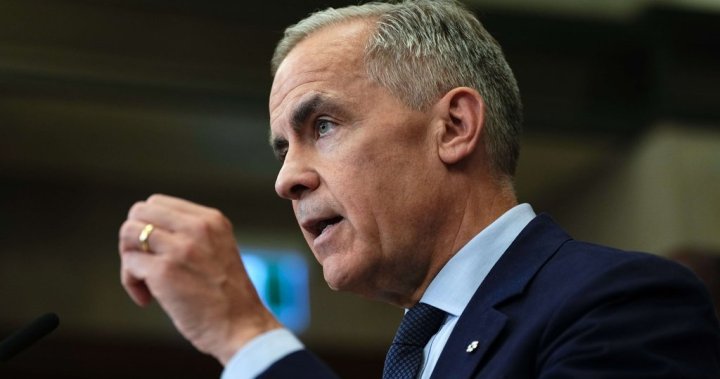Federal and provincial leaders are working to dismantle internal trade barriers that push up the cost of goods and make it harder to do business within Canada.
But anyone expecting all of them to be gone by tomorrow should read the fine print.
Throughout the spring federal election campaign, Liberal Leader Mark Carney repeatedly vowed to “eliminate” interprovincial trade barriers and create “free trade by Canada Day.”
The rhetoric has been at times confusing and the political scorecard on this one is hard to track.
With July 1 just a day away, Carney’s government has passed its planned changes into law — but it’s more like the start of a conversation than the final word.
“It’s a starting gun and it’s starting a lot more activity and work, which is honestly the really exciting part,” said internal trade expert Ryan Manucha. “If any of this was easy, it would have been done.”
Manucha writes on the topic for the Macdonald-Laurier Institute think tank and authored the book, “Booze, Cigarettes, and Constitutional Dust-Ups: Canada’s Quest for Interprovincial Trade.”

“When I’m advising governments, I say, ‘Don’t think of this as a light switch,’” he said. “We are changing the way that everyone approaches the concept of regulation and risk here, and so it’s going to take some time.”
The rush to break down internal barriers to trade comes in response to U.S. President Donald Trump’s tariff war with Canada. One study estimates that existing internal trade hurdles cost the economy some $200 billion a year.
Manucha said Canada has talked about this problem for decades but is only addressing it seriously now — and it would “never have happened had we not had Trump.”
He said the introduction of the Carney government’s bill on internal trade was “incredible to see” because the idea was just “an academic theory maybe even as little as eight months ago.”

Get daily National news
Get the day’s top news, political, economic, and current affairs headlines, delivered to your inbox once a day.
Bill C-5, the omnibus bill that reduces federal restrictions on interprovincial trade and also speeds up permitting for large infrastructure projects, became law on June 26.
An analysis of the law by McMillan Vantage says that “this legislation would not achieve” the elimination of all internal trade barriers.
When Carney made his campaign promise, he was talking about cutting red tape put up by the federal government — not the rules set by the provinces, which have the most authority in this area.
The prime minister described this effort as a sort of quid pro quo with the provinces.

“We’re getting rid of a bunch of duplicative federal regulations. We’re going to have a principle of one project, one review — and in exchange, they’re going to agree to eliminate all the barriers to trade and labour mobility,” Carney said at a rally in Kitchener, Ont., on March 26.
“The federal government committed that we will sweep away all of our impediments by Canada Day. Free trade by Canada Day.”
But Canada’s internal trade barriers won’t all be eliminated by then — not even all the federal ones.
Canada’s supply management system for dairy products, which sets provincial production quotas, will remain in place. Quebec also retains language requirements that will stay in place.
Credit unions have complained that the new law does not break down barriers to their expansion into multiple provinces.
Bill C-5 aligns federal requirements for goods and services with provincial ones if they cross provincial or territorial borders. It allows the provincial requirement to replace a federal one if the rules are “comparable.”
Ottawa likes to point to energy efficiency standards. A washing machine made in B.C. that meets the provincial standard still needs to meet additional federal standards before it can be sold in Alberta or Ontario. But this new law means the B.C. standard would replace the federal one.
The law also eliminates redundant licensing requirements for labourers. Federal regulators would have to recognize provincial occupational certifications.
So just how many federal barriers does the bill eliminate? That’s hard to sort out. A lot of the details will have to wait until regulations are drafted — a process that will involve consultations with affected industries.
“I don’t really know what this legislation could end up doing because a lot of veto power, a lot a discretion still rests with the regulatory authorities,” Manucha said.
“According to the text of that legislation, it would seem like meat inspection would come off. Is (the Canadian Food Inspection Agency) really going to allow for interprovincial trade and inspection of meat coming from non-federally licensed abattoirs? I don’t know.”

There is no comprehensive list of existing internal trade barriers. Even some lobby groups have told parliamentarians they don’t know how many barriers their own industries face.
There isn’t even consensus on what all counts as a trade barrier.
“In the provincial legislation in Ontario, they’re talking for many occupations having a 30-day service standard for how long it’ll take for credentials to be recognized,” Manucha said. “Nova Scotia, meanwhile, is on the 10-day turnaround time. That’s less than a third. Can you call the 30-day versus 10-day a trade barrier?”
Internal Trade Minister Chrystia Freeland, who has repeatedly stated that most of the barriers are at the provincial level, testified to the Senate that she will meet with her provincial counterparts on July 8 to discuss next steps.
One major obstacle is in Freeland’s crosshairs: Canada’s patchwork of interprovincial trucking regulations.
“One of three areas that I will be putting on the agenda at that meeting is trucking,” she said on June 16. “It should be a lot easier than it is to drive a truck from Halifax to Vancouver. We need to get rid of conflicting requirements.”
© 2025 The Canadian Press




